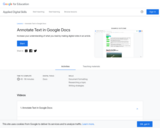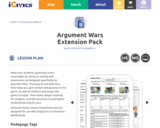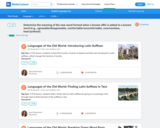
Teach language, vocabulary and listening comprehension with Celebrity Vocab clips! [2:03]
- Subject:
- Arts
- English Language Arts
- Material Type:
- Audio/Video
- Provider:
- PBS LearningMedia
- Date Added:
- 12/01/2022

Teach language, vocabulary and listening comprehension with Celebrity Vocab clips! [2:03]

Are your students having difficulty understanding math terminology? Try this A-Z glossary on math related terms. It's quick, easy to read, and very complete.

his lesson uses music and art in a vocabulary study of unfamiliar words from the song "America the Beautiful," increasing students' vocabulary while also increasing their knowledge of U.S. geography. A discussion to activate students' prior knowledge about sights and scenery throughout the United States is followed by a read-aloud and introduction to the song "America the Beautiful," which is then sung in each session of the lesson. Students learn the meanings of the song's words through shared reading and the use of context clues and images. Students then use photographs, illustrations, and descriptive language to create a mural shaped like the United States. Finally, through pictures and words, students reflect on what they have learned. This lesson is appropriate and adaptable for any patriotic event or holiday, and many of the vocabulary strategies are adaptable for other texts or word lists, as well.

Teach language, vocabulary and listening comprehension with Celebrity Vocab clips! [1:49]

Teach language, vocabulary and listening comprehension with Celebrity Vocab clips! [1:22]

Increase your understanding of what you read by making digital notes in an article. Time to complete: 45-90 minutes

Make your students' game play more meaningful by using our activity and assessment set designed specifically for Argument Wars. This easy-to-use Extension Pack helps you give context and purpose to the game, as well as reinforce and assess the game concepts. That means deeper learning for students, and best practices around game-centered learning for you!
Extension Packs require PowerPoint and are designed for use with projectors or interactive whiteboards. LESSON OBJECTIVES: Explore the nature of court cases about constitutional rights *Analyze the kinds of support used to argue a constitutional rights case *Identify appropriate arguments for landmark Supreme Court cases
![ArtsNow Learning: Dr. Seuss Is on the Loose [PDF]](https://openspace.infohio.org/static/newdesign/images/materials/default-thumbnail-index.png)
The rhythmic and melodic elements of Theodor Geisel's children's literature provide many opportunities for knowledge of language, vocabulary acquisition and use, and creative expression and communication in music. Students work with two books in this lesson - Dr. Seuss's ABC and P.D. Eastman's Go, Dog. Go!

Teach language, vocabulary and listening comprehension with Celebrity Vocab clips! [1:42]

This website from the BBC is a great introduction to averages (mean, median, and mode) and will take you through some interactive learning activities. A practice test and worksheet are also provided.

Follow this link to the British Film Institute's glossary of film and television terms.

Sorting items help students develop language skills as they describe attributes and qualities to determine which category is the best fit for an item. The teacher will introduce the definitions of wild and domestic by reading the book Growing Up Wild. After a discussion, the students will sort through animals and decide whether it is wild or domestic. Supporting materials, an assessment checklist, and examples of student work are included.

As we expose our students to different ideas, it is important they see that not all words come from books- some of our best ideas come from conversations and things we see or do! A quick, easy and free way to help our students get exposure to rich language is to simply change the names of our classroom jobs. Included is a "Gold Collar Jobs Poster", and videos/pictures of the lesson in action.

Links to 5 lessons and activities that build student skills in standard L.3.4b: Determine the meaning of the new word formed when a known affix is added to a known word (e.g., agreeable/disagreeable, comfortable/uncomfortable, care/careless, heat/preheat).

Links to 2 lessons and activities that build student skills in standard L.3.4d: Use glossaries or beginning dictionaries, both print and digital, to determine or clarify the precise meaning of key words and phrases.

Links to 6 lessons and activities that build student skills in standard L.3.5b: Identify real-life connections between words and their use (e.g., describe people who are friendly or helpful).

Links to 10 lessons and activities that build student skills in standard L.4.6: Acquire and use accurately grade-appropriate general academic and domain-specific words and phrases, including those that signal precise actions, emotions, or states of being (e.g., quizzed, whined, stammered) and that are basic to a particular topic (e.g., wildlife, conservation, and endangered when discussing animal preservation).

SWBAT define words using a child friendly definition while adding an action in order to retain the meaning of new words.

This site provides 17 English language arts lessons for 7th grade. Grade-level standards are provided.

Kindergarteners take ownership of the JUICY words they learn by hearing them, practicing them, and checking them. The following routine supports children to own their words! Instead of the teacher introducing the word and giving the definition to students, students are involved in the process of explaining the word and are in charge of remembering enough to teach each other!